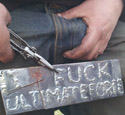|
Automotive Fabrication Insanity About Me I weld thing professionally. Types of Welding MIG ”Wikipedia” posted:Gas metal arc welding (GMAW), sometimes referred to by its subtypes metal inert gas (MIG) welding or metal active gas (MAG) welding, is a welding process in which an electric arc forms between a consumable wire electrode and the workpiece metal(s), which heats the workpiece metal(s), causing them to melt, and join. TIG ”Wikipedia” posted:Gas tungsten arc welding (GTAW), also known as tungsten inert gas (TIG) welding, is an arc welding process that uses a non-consumable tungstenelectrode to produce the weld. The weld area is protected from atmospheric contamination by an inert shielding gas (argon or helium), and a filler metal is normally used, though some welds, known as autogenous welds, do not require it. A constant-current welding power supply produces electrical energy, which is conducted across the arc through a column of highly ionized gas and metal vapors known as a plasma. Tungsten Selection I wrote this for a failed project I was working on. In an effort to keep shop costs down and simplify my work area I really try to use only two types of tungsten, 2% thoriated and 2% ceriated. I could use ceriated for pretty much everything that comes into our shop, but I like how long thoriated keeps a point when welding at higher amperage. One thing I can't stress enough is that pure tungsten is terrible and I never use it. Welding with a giant ball on the tip is the worst.   Nearly all of the time I use 3/32" sized tungsten. It's a good all-around amperage size that comes in handy for just about everything I need to weld. I do, however, keep 1/16" and 1/8" stocked just in case. When it comes to grinding the tips I am a firm believer in a sharp, steeply ground tip. It's best to grind the very tip off the end but I recommend experimenting with what works best for you. Here's how I typically prepare tungsten for welding steel.   For aluminum I sharpen the tip to a point then grind off a good portion of the face leaving it flat. After that I slowly bring the arc up to around 100 amps on the table to let the point ball slightly. If the ball starts to get too large I will regrind the tip down but leave the face rounded. Pure tungsten will create a large ball on the end, which I personally think is terrible. It more sprays the arc at the material rather than point it at the work area. If you really like that sort of thing, save the death threats to my email, keep using it. Update: At work I only use purple “E3” tungsten. It’s not radioactive and keeps a good point. You are supposed to be able to use it on aluminum and steel, but I only weld steel at work. More on sharpening! There are quite a few ways to sharpen your tungsten, some of which I personally think are stupid and a waste of time and money.  At work we have a DGP-PG3 Piranha III tungsten sharpener. We have like five of these and they are a huge waste of money and should be scrapped. We had to build stands for them in between rows of welding booths. At least it gives people time to goof off as they stand around this pseudo water cooler. Grinding on a wheel is nice though as it does provide a nice smooth face on the tungsten point. Way too expensive for home or shop use in my opinion. You can buy one there though: http://www.diamondground.com/tungsten-electrode-grinders/dgp-pg3-piranha-iii-tungsten-electrode-grinder/ Alternatively you could get what I personally use and carry around every day, a portable sharpener.  My coworkers say I wasted money on this but they sure do get jealous when I use it. I love this little thing. Really consistent sharpens and small enough that I carry it around wherever the wind blows me around the shop. It is pricey but I like to think I’m worth it. Those with deep enough pockets can get one here: https://www.arc-zone.com/index.php?...ffof2bkhc09pcla Now for the cheaper options there are belt sanders and grinding wheels. Both aren’t too bad and work great on a budget.  If you have a portable drill laying around you can get some really nice sharpens on a setup like this. I prefer the belt but a grinding wheel works fine after a groove is worn in to it. Keep in mind once you start to get serious about welding you should dedicate a grinding station just for tungsten and no other materials. I will get into belt types in another part of this post. How to shape tungsten points How you make the point on tungsten is actually very important if you are ready to make consistent welds every time. I have my sharpener set by eye to the kind of point I like, but fancier setups can dial in a specific degree.  I sharpen to a fine point which gives me less penetration but I like how fast the arc starts, which is critical in a lot of the repairs I do. There is definitely a point where you can make a sharpen at a degree that makes the tungsten unuseable. Shielding Gas I only use pure argon when TIG welding. If I need more heat for aluminum (welding transmission bell housings for example) I will preheat it. Pre-Heating Aluminum A small oven is great if you have the space. Scrap the burners off the top for taco money. The bonus of a oven is you will get a nice even pre-heat. The old school way of preheating is using an oxy torch. A rose bud works fine, but if you only have a cutting tip set the mixture too rich so it belches smoke. Cover the part in soot, adjust the flame to neutral and burn off the soot. When the surface is clean the part is hot and ready to weld. This works GREAT on welding oily cast stuff. Gas Lenses and Cup Sizing I use standard gas lens with a number 8 cup on most projects with 15 CFM gas flow. I’ve used a lot of brands of lenses but Miller lenses seem to always be the best. Cheaper components can have flow problems and will make your weld look like poo poo. More reading: http://www.millerwelds.com/resources/articles/Gas-lenses-TIG-GTAW-welding/ Oxyacetylene ”Wikipedia” posted:Oxy-fuel welding (commonly called oxyacetylene welding, oxy welding, or gas welding in the U.S.) and oxy-fuel cutting are processes that use fuel gases and oxygen to weld and cut metals, respectively. French engineers Edmond Fouché and Charles Picard became the first to develop oxygen-acetylene welding in 1903. Pure oxygen, instead ofair, is used to increase the flame temperature to allow localized melting of the workpiece material (e.g. steel) in a room environment. A common propane/air flame burns at about 2,250 K (1,980 °C; 3,590 °F), a propane/oxygen flame burns at about 2,526 K (2,253 °C; 4,087 °F), and an acetylene/oxygen flame burns at about 3,500 °C (6,330 °F). Shop Tools Hand Tools  I am a big believer in having a hand held belt sanders, commonly known by the brand name Dynafile. http://www.abrasivesupply.com/Dynabrade_Dynafile_Belt_Sanders_s/59.htm You know that tool you always wish you had? Well this is it. I use these all day at work and it’s the best way to debur the inside of stainless steel pipe or tube. It’s really great at spot sanding little things that are in hard to reach spots. You can get Harbor Freight versions for cheap and they actually work great if you keep them oiled. One of the few knock-off tools worth spending money on.  Find yourself a good angle grinder that is the right size to be held in one hand. It should have a lock on the switch to keep it running. I had an expensive Makita one that I burned out and I’ve also had cheap Harbor Freight ones I’ve burned out. Just get one that’s comfortable to use then get an expensive one for grinding heavy duty stuff on the side.  http://www.harborfreight.com/3-in-heavy-duty-electric-cut-off-tool-68523.html I have plenty of pneumatic tools but the Harbor Freight electric cut-off tool is amazing. It’s really light, doesn’t need a big air hose, and cuts really straight. Air tools tend to wobble slightly and wear out the abrasive blade faster. If I am cutting a bracket off something under a car I am using this. Production Equipment Material Types Mild Steel Aluminum Stainless Steel Prepping Metal Projects Headers Exhaust Engine Mounts ultimateforce fucked around with this message at 17:10 on Sep 12, 2015 |
|
|
|

|
| # ? May 8, 2024 20:39 |
|
I think I'll make use of this thread. I've purchased some stuff to do welding. Once I can lay down an artful bead on some DOM I'll be fabricating a loors sr1 style stadium racer based off a Kawasaki Teryx utv I recently purchased. Basically something just like this http://www.teryxforums.net/teryx-pictures-videos/25810-my-new-toy.html
|
|
|
|
Never seen a gas cup like that. What are the benefits compared to the standard pink ones? e: besides looking awesome
|
|
|
|
charliemonster42 posted:Never seen a gas cup like that. What are the benefits compared to the standard pink ones? Pyrex cups add additional gas coverage and visibility. They are also very fragile.
|
|
|
|
charliemonster42 posted:Never seen a gas cup like that. What are the benefits compared to the standard pink ones? I'll add stuff about cups and lenses in the TIG section.
|
|
|
|
What, no stick welding?! No fluxcore?! I would really love to hear about TIG gas selection, lens/cup choice, and tungsten sizing, so I'll keep an eye on this.
|
|
|
|
kastein posted:What, no stick welding?! No fluxcore?! I am adding stuff every day when I get home, but I ONLY use straight argon for TIG welding.
|
|
|
|
Seeing as I'd like to learn how to weld, this thread is going to be good poo poo. Thank you.
|
|
|
|
Have you ever ran strait CO2 for your gas on MIG? I hear it will make a hotter process so you can do some deeper penetration with less amps. I plan to try it along with just running Tri-mix from airgas. But I do want to see more about stick. How do you select the rod to go with the thickness of steel? I know stick is much better for doing heavy poo poo compared to mig.
|
|
|
|
BrokenKnucklez posted:Have you ever ran strait CO2 for your gas on MIG? I hear it will make a hotter process so you can do some deeper penetration with less amps. I plan to try it along with just running Tri-mix from airgas. I know from experience other mixes such as straight CO2 will help you penetrate, along with tri-mix, but I stick with the regular 75% argon 25% CO2 mix. If I have to weld something that heavy I will use a more powerful 220v MIG welder. I have never stick welded and I have never even heard of someone stick welding on car projects. You are looking for a more industrial application thread!
|
|
|
|
GMAW/MIG is often used on thick metal (FCAW as well but its more limited to structural stuff). We are welding around 50 mm thick joints with GMAW that are phased array ultrasonic tested. People like SMAW/stick for low temp qualities and lower heat input. You get into stuff about the size of the rod or wire in relation to the puddle too.
|
|
|
|
BrokenKnucklez posted:Have you ever ran strait CO2 for your gas on MIG? I hear it will make a hotter process so you can do some deeper penetration with less amps. I plan to try it along with just running Tri-mix from airgas. The CC where I took welding used only co2 due to cost. It works great with heavy gauge stuff but it is really easy to blow holes in thin sheet. When I switched to C25 after a whole semester of co2, it was so much easier to weld sheet. The fab shop I worked at would only use stick on farm implements. I should write something on machining...
|
|
|
|
Timmy Cruise posted:phased array ultrasonic tested. . Would like to know more about this. Sounds much more useful than X-ray testing. We ran into some serious delays on a project due to the x-ray technicians not being diligent in their testing process and waiting until we'd welded both sides of the weld to take any shots. Then they found shadows and they might have been in one side or the other of the welds or it might have been in the fit up and there's just no way to tell so lets just take grinders to it and redo until they go away but now they're moving and there's new ones over here that weren't there before and we need to fix those, too. Long story short, I'm not happy about that company and their procedures, but we didn't hire them and we got shafted because of it.
|
|
|
|
charliemonster42 posted:Would like to know more about this. Sounds much more useful than X-ray testing. We ran into some serious delays on a project due to the x-ray technicians not being diligent in their testing process and waiting until we'd welded both sides of the weld to take any shots. Then they found shadows and they might have been in one side or the other of the welds or it might have been in the fit up and there's just no way to tell so lets just take grinders to it and redo until they go away but now they're moving and there's new ones over here that weren't there before and we need to fix those, too. That sounds pretty iffy but we don't get anything shot or scanned until its done. Did they let your company look at the film? What is the application? I.e. ASME vessels The details of how phased array is done are online but the catch is it does see more on thicker sections than cobalt source radiography. This can make it more difficult to pass welds and makes things like ckeaning between passes all the more critical.
|
|
|
|
There is a general blacksmithing, metalworking & welding thread in DIY here: Blacksmithing / Metalwork: Anything involving penetration has to be anodized. It has a fair amount of general welding stuff you could probably just copy over on the first page of posts. I see this as a more specifically automotive-welding and fabrication thread (which is awesome) so maybe linking to that thread in your OP and for general welding info is an option.
|
|
|
|
Is this where I can come to be actively made fun of for my lovely TIG welds made with a Chinese Everlast welder? We use the same brand of tungsten though so And actually on the topic of sharpening tungstens, I'm assuming professionals like UF have a nice dedicated sharpener on hand, but if you're a beginner and easy option is putting the tungsten in a drill and putting a dedicated grinding stone in your dremel then run the two against each other. From what I've read it seems like a much better affordable option than the chemical dips.
|
|
|
|
Keep in mind if you're using thoriated tungsten it is (maybe slightly I dont know actual levels) radioactive and you should use proper ppe...
|
|
|
|
Timmy Cruise posted:Keep in mind if you're using thoriated tungsten it is (maybe slightly I dont know actual levels) radioactive and you should use proper ppe... And lanthanated is far better on Inverter machines. And less toxic. There are also Ti covers for the Pyrex cups to help with breakage. I'm all in on this thread, UF, please keep it up.
|
|
|
|
Timmy Cruise posted:That sounds pretty iffy but we don't get anything shot or scanned until its done. Did they let your company look at the film? I believe it was done under ASME section 9. It was a large diameter (~6.5') pipe with 1.25" wall thickness running at 450 ft of head. The owner of the project is large enough that they have their own in house inspection department that writes the procedures and such for the welds. They subcontract their x-ray testing to a firm that seems to have a good setup but lovely people running it. At least part of the problem was due to the testing all being done on night shift and the fatigue that brings. It was generally a colossal poo poo show. tl, dr: being a privately held utility company allows you to get away with some poo poo.
|
|
|
|
Timmy Cruise posted:Keep in mind if you're using thoriated tungsten it is (maybe slightly I dont know actual levels) radioactive and you should use proper ppe... Good point and reminder, I specifically avoid using thoriated because I don't want to deal with the health risk.
|
|
|
|
Also keep in mind that all arc welding produces copious amounts of UV, which will cancer the gently caress out of your skin if you don't cover it up.
|
|
|
|
Leperflesh posted:Also keep in mind that all arc welding produces copious amounts of UV, which will cancer the gently caress out of your skin if you don't cover it up. And convert TCE (Chlorinated brake-clean) to Phosgene gas. \/\/ Ah gently caress, you're right... Edited. sharkytm fucked around with this message at 21:05 on Aug 28, 2015 |
|
|
|
sharkytm posted:And convert Acetone to Phosgene gas. Not acetone, acetone has no chlorine in it and that's necessary to produce phosgene. Acetone actually mostly just burns, it's one of the more benign solvents to weld near. Brakleens that contain chlorine though? Bad news. Real bad news. I don't even buy chlorinated stuff because I know I'm gonna be a doofus and weld near it eventually, so I stick with the stuff that simply catches fire and doesn't kill you.
|
|
|
|
Leperflesh posted:Also keep in mind that all arc welding produces copious amounts of UV, which will cancer the gently caress out of your skin if you don't cover it up. I worked with a guy who was a walking lesson in why you don't just close your eyes and turn your head if you "just need to tack something quick." Years of that practice gave him some nasty cancer on his neck/face. Really sucks, but on the upside, he was a huge safety guy after that and hounded everyone to wear goggles, use hearing protection, cover up, wear a respirator, etc.
|
|
|
|
For what is worth, there is a guy on youtube by the user name of Chuckee2009 - hes not the best welder in the world, but hes great for the hobbiest like a giant majority of us, he has lots of good reviews of the chinese machines plus the big name brand ones as well. He can be amusing and also annoying, but he does have good insight. Also Kevin Caron - another you tube guy - hes got some good stuff. His voice annoys me, but he does give good points as well. I always feel welding is like politics. The basics are similar, but every one has their own opinion on how to do it. BrokenKnucklez fucked around with this message at 22:47 on Aug 28, 2015 |
|
|
|
BrokenKnucklez posted:For what is worth, there is a guy on youtube by the user name of Chuckee2009 - hes not the best welder in the world, but hes great for the hobbiest like a giant majority of us, he has lots of good reviews of the chinese machines plus the big name brand ones as well. I really like Jody from weldingtipsandtricks.com. He has ADD so he kinda jumps all over the place but he answers all the questions in the comments and he knows how to weld anything in every possible way
|
|
|
|
Just a reminder I am writing this in the order of more interest to me so it's going to be very jumbled till I'm done. I'll be posting about tools next I think.
|
|
|
|
TWSS posted:I really like Jody from weldingtipsandtricks.com. He has ADD so he kinda jumps all over the place but he answers all the questions in the comments and he knows how to weld anything in every possible way He doesn't know everything, but he's a solid resource, and is quick to admit when he's out of his depth, or when he screws up on video. I'm a big fan, and watch everything he produces, even though I haven't picked up a welding lead in 2 years.
|
|
|
|
How do you feel about the Chineseium palsma cutters? I have seen quite a few of the CUT50 models and people actually said they aren't complete poo poo and for light poo poo (which it would mostly be anything 1/8th inch and under steel. I can use a grinder with a cutting wheel, but I think a plasma cutter would have more use for auto body poo poo. I mean, Miller or Lincoln would be awesome, but that's also 12-1400 bucks for a machine, and I'd rather spend money else where.
|
|
|
|
TWSS posted:I really like Jody from weldingtipsandtricks.com. He has ADD so he kinda jumps all over the place but he answers all the questions in the comments and he knows how to weld anything in every possible way I also like this guy Chuck (?) when I remember I'll sometimes fire up his channel and see whats hes up too, then promptly loose an entire evening. https://www.youtube.com/user/ChuckE2009
|
|
|
|
WELDING https://www.youtube.com/watch?v=pYLarA54Xgc
|
|
|
|
I'm struggling with blowing holes in 22 gauge sheet metal. I have my heat on the lowest setting, .030 wire, 25/75 mix for gas with 30 on the flow. I move my gun pretty quick but I'm struggling still. Should I move down to .023 wire?
|
|
|
|
I can only see it as giving you more flexibility, but I don't do a lot of work related to that thin of metal. Can you adjust voltage separately or only heat?
|
|
|
|
It's on 1 which I assume it's the lowest setting for volts/heat. FWIW - Hobart Auto Arc 130
|
|
|
|
I have some questions about welding some headers to plug the air injection ports. These are from an E36 BMW and I am led to believe they are 409 stainless steel. From the research I have done, it seems that a 309L filler is called for if TIG is used and the appropriate filler for MIG is not readily available in small quantities (ER409). To TIG this means filling a large area of the mounting flange and I would think that warpage would be an issue. 1. Can I use 316L filler rod to fill in ports on a 409 header (thinking NO)? 2. Is 309L the right filler to use on a 409 header? 3. Would machining a bung of 409 steel to weld in be the best option?
|
|
|
|
Some info in this article: http://www.azom.com/article.aspx?ArticleID=969 Looks like you're correct on the 309 filler but you also need to preheat. If it's on a flange I would definitely be concerned with distortion. What is the connection like?
|
|
|
|
BrokenKnucklez posted:I'm struggling with blowing holes in 22 gauge sheet metal. I have my heat on the lowest setting, .030 wire, 25/75 mix for gas with 30 on the flow. I move my gun pretty quick but I'm struggling still. MonkeyNutZ fucked around with this message at 16:22 on Sep 12, 2015 |
|
|
|
That would be super helpful. I'm getting better, but need to keep playing.
|
|
|
|
Timmy Cruise posted:Some info in this article: http://www.azom.com/article.aspx?ArticleID=969 Thanks, I had not found that link. It does confirm the 309 filler and the pre-heat is something that other sites had indicated as being unneeded. I think I will go with a pre-heat cycle. The air injection port connects to two of the three exhaust ports and ideally I would plug both the hole and the channel between the ports:  The other side:  My current plan is to machine a plug out of 304 stainless and TIG weld it in with 309 filler and pre-heat. I could not find a convenient source of 409 stock to make the plug from and am still looking for some 309 filler. I have seen pictures of other welded headers and it seem like people just went nuts and goobered the whole thing closed. I will also spend some time knocking off the weld splatter from the inside of the headers.
|
|
|
|

|
| # ? May 8, 2024 20:39 |
|
ZincBoy posted:Thanks, I had not found that link. It does confirm the 309 filler and the pre-heat is something that other sites had indicated as being unneeded. I think I will go with a pre-heat cycle. That looks like a decent spot for Silicone Bronze filler, or even Tig-braze. You'd need a lot less heat.
|
|
|





















